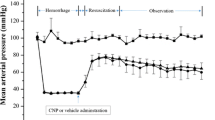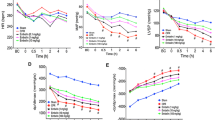Abstract
Severe hemorrhage shock and resuscitation (HSR) has been reported to induce myocardial ischemia–reperfusion injury (MIRI), resulting in a poor prognosis. Hirudin, an effective thrombin inhibitor, can offer protection against MIRI. This study aimed to determine if hirudin administration ameliorates HSR-induced MIRI and the underlying mechanism. A rat model of HSR was established by bleeding rats to a mean arterial blood pressure of 30–35 mmHg for 45 min and then resuscitating them with all the shed blood through the left femoral vein. After HSR, 1 mg/kg of hirudin was administrated immediately. At 24 h after HSR, the cardiac injury was assessed using serum CK-MB, cTnT, hematoxylin–eosin (HE) staining, echocardiography, M1-polarized macrophages, and pyroptosis-associated factors, including cleaved caspase-1, Gasdermin D (GSDMD) N-terminal, IL-1β, and IL-18 were measured by immunofluorescence and western blot assays. Nigericin, a unique agonist, was utilized to evaluate the responsibilities of NLRP3 signaling. Under the HSR condition, rats exhibited a significant increase in myocardial injury score, an elevation of serum cTnT, CK-MB levels, an aggrandization of M1-polarized macrophages, an upregulation of pyroptosis-associated factors, including cleaved caspase-1, GSDMD N-terminal, IL-1β, and IL-18, but a significant decrease in left ventricular ejection fraction (EF%) and a reduction of left ventricular fractional shortening (FS%), while hirudin administration partially restored the changes. However, the NLRP3 agonist nigericin reversed the cardioprotective effects of hirudin. We determined the cardioprotective effects of hirudin against HSR-induced MIRI. The mechanism may involve the inhibition of NLRP3-induced pyroptosis.





Similar content being viewed by others
Data availability
The data and materials that support the findings of this study are available from the corresponding author upon reasonable request.
References
Hutchings SD, Naumann DN, Hopkins P, Mellis C, Riozzi P, Sartini S, Mamuza J, Harris T, Midwinter MJ, Wendon J (2018) Microcirculatory impairment is associated with multiple organ dysfunction following traumatic hemorrhagic shock: The MICROSHOCK study. Crit Care Med 46(9):e889–e896
Matot I, Cohen K, Pappo O, Barash H, Abramovitch R (2008) Liver response to hemorrhagic shock and subsequent resuscitation: MRI analysis. Shock 29(1):16–24
Wang XP, Zheng WC, Bai Y, Li Y, Xin Y, Wang JZ, Chang YL, Zhang LM (2021) Carbon monoxide-releasing molecule-3 alleviates Kupffer cell pyroptosis induced by hemorrhagic shock and resuscitation via sGC-cGMP signal pathway. Inflammation 44(4):1330–1344
Owattanapanich N, Chittawatanarat K, Benyakorn T, Sirikun J (2018) Risks and benefits of hypotensive resuscitation in patients with traumatic hemorrhagic shock: a meta-analysis. Scand J Trauma Resusc Emerg Med 26(1):107
Nandra KK, Takahashi K, Collino M, Benetti E, Wong WS, Goh FY, Suzuki K, Patel NS, Thiemermann C (2012) Acute treatment with bone marrow-derived mononuclear cells attenuates the organ injury/dysfunction induced by hemorrhagic shock in the rat. Shock 37(6):592–598
Buja LM (2005) Myocardial ischemia and reperfusion injury. Cardiovasc Pathol 14(4):170–175
Liu Y, Zhang J, Zhang D, Yu P, Zhang J, Yu S (2022) Research progress on the role of pyroptosis in myocardial ischemia-reperfusion injury. Cells 11(20):3271
Wang Z, Zhang S, Xiao Y, Zhang W, Wu S, Qin T, Yue Y, Qian W, Li L (2020) NLRP3 Inflammasome and Inflammatory Diseases. Oxid Med Cell Longev 2020:4063562
Amin J, Boche D, Rakic S (2017) What do we know about the inflammasome in humans? Brain Pathol 27(2):192–204
Yu P, Li Y, Fu W, Li X, Liu Y, Wang Y, Yu X, Xu H, Sui D (2020) Panax quinquefolius L. saponins protect myocardial ischemia reperfusion no-reflow through inhibiting the activation of NLRP3 inflammasome via TLR4/MyD88/NF-kappaB signaling pathway. Front Pharmacol 11:607813
Dai Y, Wang S, Chang S, Ren D, Shali S, Li C, Yang H, Huang Z, Ge J (2020) M2 macrophage-derived exosomes carry microRNA-148a to alleviate myocardial ischemia/reperfusion injury via inhibiting TXNIP and the TLR4/NF-κB/NLRP3 inflammasome signaling pathway. J Mol Cell Cardiol 142:65–79
Hesse J, Leberling S, Boden E, Friebe D, Schmidt T, Ding Z, Dieterich P, Deussen A, Roderigo C, Rose CR et al (2017) CD73-derived adenosine and tenascin-C control cytokine production by epicardium-derived cells formed after myocardial infarction. FASEB J 31(7):3040–3053
Popovic B, Sorbets E, Abtan J, Cohen M, Pollack CV, Bode C, Wiviott SD, Sabatine MS, Mehta SR, Ruzyllo W et al (2021) Outcomes in non-ST-segment elevation myocardial infarction patients according to heart failure at admission: Insights from a large trial with systematic early invasive strategy. Eur Heart J Acute Cardiovasc Care 10(7):736–745
Mo G, Liu X, Zhong Y, Mo J, Li Z, Li D, Zhang L, Liu Y (2021) IP3R1 regulates Ca2+ transport and pyroptosis through the NLRP3/Caspase-1 pathway in myocardial ischemia/reperfusion injury. Cell Death Discov. https://doi.org/10.1038/s41420-021-00404-4
Cinteza M (2019) OK-flow sorry - no-reflow. Maedica (Bucur) 14(4):323–325
Bian Y, Li X, Pang P, Hu XL, Yu ST, Liu YN, Li X, Wang N, Wang JH, Xiao W et al (2020) Kanglexin, a novel anthraquinone compound, protects against myocardial ischemic injury in mice by suppressing NLRP3 and pyroptosis. Acta Pharmacol Sin 41(3):319–326
Yu C, Wang W, Jin X (2018) Hirudin protects Ang II-induced myocardial fibroblasts fibrosis by inhibiting the extracellular signal-regulated kinase1/2 (ERK1/2) pathway. Med Sci Monit 24:6264–6272
Zhang H, Chen H, Li J, Bian Y, Song Y, Li Z, He F, Liu S, Tsai Y (2020) Hirudin protects against isoproternol-induced myocardial infraction by alleviating oxidative via an Nrf2 dependent manner. Int J Biol Macromol 162:425–435
Li WQ, Qin ZS, Chen S, Cheng D, Yang SC, Choi YMM, Chu B, Zhou WH, Zhang ZJ (2022) Hirudin alleviates acute ischemic stroke by inhibiting NLRP3 inflammasome-mediated neuroinflammation: in vivo and in vitro approaches. Int Immunopharmacol 110:108967
Maeshima K, Takahashi T, Uehara K, Shimizu H, Omori E, Yokoyama M, Tani T, Akagi R, Morita K (2005) Prevention of hemorrhagic shock-induced lung injury by heme arginate treatment in rats. Biochem Pharmacol 69(11):1667–1680
Inoue K, Takahashi T, Uehara K, Shimuzu H, Ido K, Morimatsu H, Omori E, Katayama H, Akagi R, Morita K (2008) Protective role of heme oxygenase 1 in the intestinal tissue injury in hemorrhagic shock in rats. Shock 29(2):252–261
Antonopoulos C, Russo HM, El Sanadi C, Martin BN, Li X, Kaiser WJ, Mocarski ES, Dubyak GR (2015) Caspase-8 as an Effector and Regulator of NLRP3 Inflammasome Signaling. J Biol Chem 290(33):20167–20184
Rong F, Peng Z, Ye MX, Zhang QY, Zhao Y, Zhang SM, Guo HT, Hui B, Wang YM, Liang C et al (2009) Myocardial apoptosis and infarction after ischemia/reperfusion are attenuated by kappa-opioid receptor agonist. Arch Med Res 40(4):227–234
Wallace KB, Hausner E, Herman E, Holt GD, MacGregor JT, Metz AL, Murphy E, Rosenblum IY, Sistare FD, York MJ (2004) Serum troponins as biomarkers of drug-induced cardiac toxicity. Toxicol Pathol 32(1):106–121
Hu X, Yang Z, Yang M, Qian J, Cahoon J, Xu J, Sun S, Tang W (2014) Remote ischemic preconditioning mitigates myocardial and neurological dysfunction via K(ATP) channel activation in a rat model of hemorrhagic shock. Shock 42(3):228–233
Del Re DP, Amgalan D, Linkermann A, Liu Q, Kitsis RN (2019) Fundamental mechanisms of regulated cell death and implications for heart disease. Physiol Rev 99(4):1765–1817
Yu P, Zhang X, Liu N, Tang L, Peng C, Chen X (2021) Pyroptosis: mechanisms and diseases. Signal Transduct Target Ther 6(1):128
Bai J, Bai Y, Wang XP, Zheng WC, Zhang LM (2021) Carbon monoxide-releasing molecule-3 ameliorates acute lung injury in a model of hemorrhagic shock and resuscitation: roles of p38MAPK signaling pathway. Shock 55(6):816–826
Lafuse WP, Wozniak DJ, Rajaram MVS (2020) Role of cardiac macrophages on cardiac inflammation, fibrosis and tissue repair. Cells 10(1):51
Yan X, Anzai A, Katsumata Y, Matsuhashi T, Ito K, Endo J, Yamamoto T, Takeshima A, Shinmura K, Shen W et al (2013) Temporal dynamics of cardiac immune cell accumulation following acute myocardial infarction. J Mol Cell Cardiol 62:24–35
Lukas P, Wolf R, Rauch BH, Hildebrandt JP, Muller C (2019) Hirudins of the Asian medicinal leech, Hirudinaria manillensis: same same, but different. Parasitol Res 118(7):2223–2233
Kostromina MA, Esipov RS, Miroshnikov AI (2012) Biotechnological production of recombinant analogs of hirudin-1 from Hirudo medicinalis. Bioorg Khim 38(2):166–176
Knobloch K, Gohritz A, Busch K, Spies M, Vogt PM (2007) Hirudo medicinalis-leech applications in plastic and reconstructive microsurgery–a literature review. Handchir Mikrochir Plast Chir 39(2):103–107
Yang K, Fan B, Zhao Q, Ji Y, Liu P, Gao S, Ren T, Dou Y, Pei M, Yang H (2020) Hirudin ameliorates renal interstitial fibrosis via regulating TGF-beta1/Smad and NF-kappaB signaling in UUO rat model. Evid Based Complement Alternat Med 2020:7291075
Swanson KV, Deng M, Ting JP (2019) The NLRP3 inflammasome: molecular activation and regulation to therapeutics. Nat Rev Immunol 19(8):477–489
Schroder K, Tschopp J (2010) The inflammasomes. Cell 140(6):821–832
Tardif JC, Kouz S, Waters DD, Bertrand OF, Diaz R, Maggioni AP, Pinto FJ, Ibrahim R, Gamra H, Kiwan GS et al (2019) Efficacy and safety of low-dose colchicine after myocardial infarction. N Engl J Med 381(26):2497–2505
Jimenez-Castro MB, Cornide-Petronio ME, Gracia-Sancho J, Peralta C (2019) Inflammasome-mediated inflammation in liver ischemia-reperfusion injury. Cells 8(10):1131
Toldo S, Marchetti C, Mauro AG, Chojnacki J, Mezzaroma E, Carbone S, Zhang S, Van Tassell B, Salloum FN, Abbate A (2016) Inhibition of the NLRP3 inflammasome limits the inflammatory injury following myocardial ischemia-reperfusion in the mouse. Int J Cardiol 209:215–220
Zhang LM, Xin Y, Wu ZY, Song RX, Miao HT, Zheng WC, Li Y, Zhang DX, Zhao XC (2022) STING mediates neuroinflammatory response by activating NLRP3-related pyroptosis in severe traumatic brain injury. J Neurochem 162(5):444–462
Funding
This study was supported by the Scientific Research Program of Hebei Administration of Traditional Chinese Medicine (NO. Z2022018) and (NO. Z2022233).
Author information
Authors and Affiliations
Contributions
LYW and YMJ: supervised the project. FW: designed the research and performed all experiment. YB and JB: completed the basic experiment part. YB and JB: performed statistical analysis. WCZ, JHW, YMJ, LYW, and PL: helped to revise the manuscript. All authors read and approved the final manuscript.
Corresponding author
Ethics declarations
Conflict of interest
The authors have no conflicts of interest to declare.
Ethical approval
The experimental animals were provided by the Animal Evaluation Committee of Hebei Province Cangzhou Hospital of Integrated Traditional and Western Medicine (Approval ID: 2021107). All procedures and experiments were performed following the protocols and instructions approved by the Cangzhou Hospital of Integrated Traditional and Western Medicine, Hebei. Protocols and details reported in this study are implemented in accordance with the guidelines Animal Research: Report of In Vivo Experiments (ARRIVE).
Additional information
Publisher's Note
Springer Nature remains neutral with regard to jurisdictional claims in published maps and institutional affiliations.
Supplementary Information
Below is the link to the electronic supplementary material.
Rights and permissions
Springer Nature or its licensor (e.g. a society or other partner) holds exclusive rights to this article under a publishing agreement with the author(s) or other rightsholder(s); author self-archiving of the accepted manuscript version of this article is solely governed by the terms of such publishing agreement and applicable law.
About this article
Cite this article
Bai, Y., Bai, J., Lu, P. et al. Hirudin ameliorates myocardial ischemia–reperfusion injury in a rat model of hemorrhagic shock and resuscitation: roles of NLRP3-signaling pathway. Mol Cell Biochem 479, 63–72 (2024). https://doi.org/10.1007/s11010-023-04717-z
Received:
Accepted:
Published:
Issue Date:
DOI: https://doi.org/10.1007/s11010-023-04717-z




